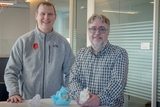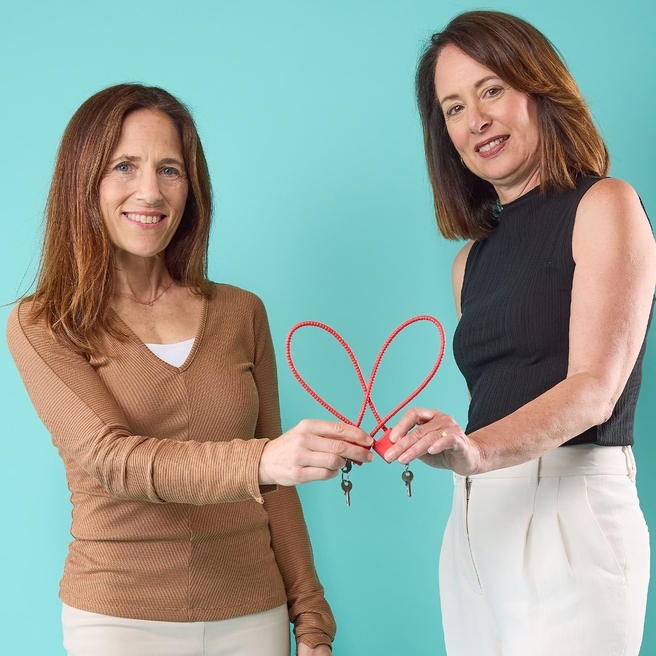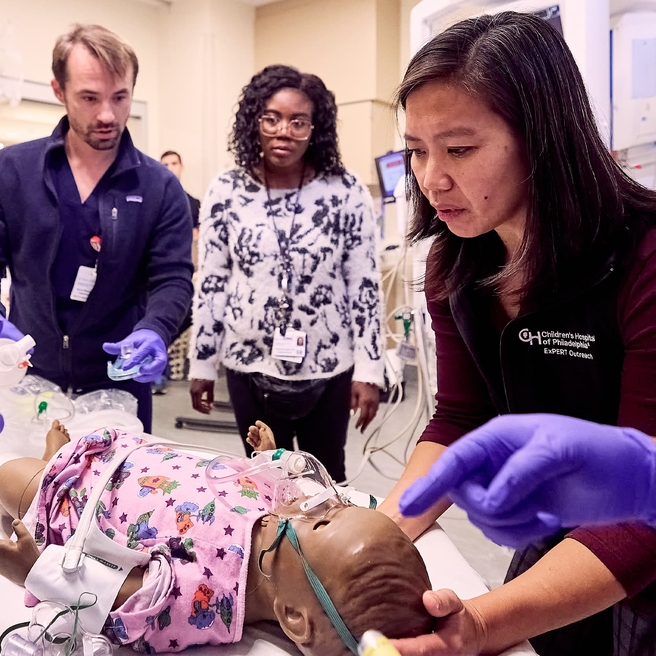

Virtual reality — once the domain of gamers — now has new applications in pediatric cardiology, and the Cardiac Center at CHOP is leading the exploration of this technology’s potential.
In the Cardiac Center’s 3D Imaging Review Suite — the result of an innovative collaboration between diagnostic imaging experts — cardiac clinicians review images from sources such as 3D echocardiograms, CTs and MRIs using virtual reality (VR) software, including SlicerVR and Elucis. The result? Realistic, 3D models that clinicians can resize, interact with and even step into.
“You feel like you’re looking at something that’s right in front of you,” says Matt Jolley, MD, cardiac anesthesiologist, cardiologist and SlicerVR contributor. “You can hold the image in your hand, you can move it, you can step into a ventricle and look around.”
With funding from the Cardiac Center’s Innovation Awards, the National Institutes of Health (NIH), the Pediatric Heart Network and Additional Ventures, Dr. Jolley’s laboratory leverages the capabilities of 3D modeling and VR to deliver highly individualized, precision care. Most recently, Dr. Jolley’s team has been developing customized software called SlicerHeart, which works in conjunction with SlicerVR to meet the specific needs of modeling for children with heart disease.
Mapping surgical procedures
Surgeons use 3D imaging technology and visualization, including 3D printed models, to carefully plan interventions and optimize patient care. In the 3D Imaging Review Suite, clinicians can review a child’s anatomy in multiple ways, including VR, ensuring they have all of the information necessary to make clinical decisions about their care.
“Ten years ago, we primarily relied on 3D printing for 3D visualization of our models,” says cardiologist Kevin Whitehead, MD, PhD. “With the advances in VR, we can more rapidly get the models into the hands of surgeons.” VR, he explains, can also give clinicians access to hidden information not visible in a 3D printed model.
Jonathan M. Chen, MD, Co-Executive Director of the Cardiac Center, says this is particularly the case when planning the repair of complex ventricular septal defects (VSD). A VSD, or “hole in the heart,” is an opening in the tissue between the heart’s lower chambers. A child with complex VSDs may have multiple openings. To plan the appropriate intervention – a minimally invasive transcatheter procedure or open-heart surgery – a cardiac clinician must know exactly where the openings are.
A 2D scan, such as a CT, may not provide this information. VR, however, shows a surgeon the child’s heart anatomy exactly as it is, from multiple angles and perspectives, prior to surgery. This eliminates surprises and prevents additional, unexpected procedures. Says Dr. Chen, “There’s nothing else that gives you that kind of GPS.”
Another primary clinical use of VR is in planning the placement of intracardiac baffles — or tunnel connections — through which surgeons direct blood flow in complicated reconstructive heart surgeries. Using VR and a technique called digital subtraction, surgeons identify the best pathways for these tunnels without the time or cost associated with 3D printing.
Virtual device selection and development
Cardiac interventionalists in the Topolewski Pediatric Heart Valve Center at CHOP also use virtual reality to inform device selection for transcatheter procedures. Many commercial valves are designed for adults and aren’t small enough for children. For children with rare heart disease, sometimes valves don’t exist at all.
Using SlicerVR technology and scans of a patient’s heart anatomy, cardiac interventionalists can virtually “test” the size and placement of existing devices to determine which one will best repair the defect and help avoid unforeseen consequences. For children with rare heart disease, this software also enables clinicians to develop and test virtual prototypes of novel devices.
“Every kid is unique,” says Dr. Jolley. “Their images are unique. If you distill what we’re doing here, it’s image-based precision medicine.”
Education and data sharing
Virtual reality can also help in educating residents, fellows and surgical trainees. CHOP’s Cardiac Registry is a large collection of actual heart specimens with different types of heart disease. Because some of these hearts are old and can be easily damaged, Lindsay S. Rogers, MD, attending cardiologist and Director of Education for the Echocardiography Laboratory at CHOP, is leading a project to increase their accessibility through VR.
The project uses a technique called photogrammetry to take hundreds of pictures of each heart from multiple angles, creating a 3D image. Using VR, researchers and students can then view and interact with the image of the specimen.
“This is a great way to preserve our collection,” says Dr. Rogers. “We can now create novel educational content with the hearts that we have.”
This digitized registry, which includes hearts with rare conditions, can also be shared across institutions, benefiting pediatric heart patients all over the world.
The future of precision medicine
While other 3D technologies like 3D PDFs or printed models are often the tools of choice for surgeries outside the pericardium (the sac that surrounds the heart), VR provides a detailed image of the heart’s internal anatomy while also being less expensive and faster than other technologies. Dr. Jolley’s lab is conducting research that compares virtual reality to other 3D technologies to determine which technology is most beneficial for different types of heart disease. In addition, they hope to leverage VR capabilities to help develop a curated database that may one day inform valve repairs in children with rare heart defects.
Featured in this article
Experts
Specialties & Programs

Virtual reality — once the domain of gamers — now has new applications in pediatric cardiology, and the Cardiac Center at CHOP is leading the exploration of this technology’s potential.
In the Cardiac Center’s 3D Imaging Review Suite — the result of an innovative collaboration between diagnostic imaging experts — cardiac clinicians review images from sources such as 3D echocardiograms, CTs and MRIs using virtual reality (VR) software, including SlicerVR and Elucis. The result? Realistic, 3D models that clinicians can resize, interact with and even step into.
“You feel like you’re looking at something that’s right in front of you,” says Matt Jolley, MD, cardiac anesthesiologist, cardiologist and SlicerVR contributor. “You can hold the image in your hand, you can move it, you can step into a ventricle and look around.”
With funding from the Cardiac Center’s Innovation Awards, the National Institutes of Health (NIH), the Pediatric Heart Network and Additional Ventures, Dr. Jolley’s laboratory leverages the capabilities of 3D modeling and VR to deliver highly individualized, precision care. Most recently, Dr. Jolley’s team has been developing customized software called SlicerHeart, which works in conjunction with SlicerVR to meet the specific needs of modeling for children with heart disease.
Mapping surgical procedures
Surgeons use 3D imaging technology and visualization, including 3D printed models, to carefully plan interventions and optimize patient care. In the 3D Imaging Review Suite, clinicians can review a child’s anatomy in multiple ways, including VR, ensuring they have all of the information necessary to make clinical decisions about their care.
“Ten years ago, we primarily relied on 3D printing for 3D visualization of our models,” says cardiologist Kevin Whitehead, MD, PhD. “With the advances in VR, we can more rapidly get the models into the hands of surgeons.” VR, he explains, can also give clinicians access to hidden information not visible in a 3D printed model.
Jonathan M. Chen, MD, Co-Executive Director of the Cardiac Center, says this is particularly the case when planning the repair of complex ventricular septal defects (VSD). A VSD, or “hole in the heart,” is an opening in the tissue between the heart’s lower chambers. A child with complex VSDs may have multiple openings. To plan the appropriate intervention – a minimally invasive transcatheter procedure or open-heart surgery – a cardiac clinician must know exactly where the openings are.
A 2D scan, such as a CT, may not provide this information. VR, however, shows a surgeon the child’s heart anatomy exactly as it is, from multiple angles and perspectives, prior to surgery. This eliminates surprises and prevents additional, unexpected procedures. Says Dr. Chen, “There’s nothing else that gives you that kind of GPS.”
Another primary clinical use of VR is in planning the placement of intracardiac baffles — or tunnel connections — through which surgeons direct blood flow in complicated reconstructive heart surgeries. Using VR and a technique called digital subtraction, surgeons identify the best pathways for these tunnels without the time or cost associated with 3D printing.
Virtual device selection and development
Cardiac interventionalists in the Topolewski Pediatric Heart Valve Center at CHOP also use virtual reality to inform device selection for transcatheter procedures. Many commercial valves are designed for adults and aren’t small enough for children. For children with rare heart disease, sometimes valves don’t exist at all.
Using SlicerVR technology and scans of a patient’s heart anatomy, cardiac interventionalists can virtually “test” the size and placement of existing devices to determine which one will best repair the defect and help avoid unforeseen consequences. For children with rare heart disease, this software also enables clinicians to develop and test virtual prototypes of novel devices.
“Every kid is unique,” says Dr. Jolley. “Their images are unique. If you distill what we’re doing here, it’s image-based precision medicine.”
Education and data sharing
Virtual reality can also help in educating residents, fellows and surgical trainees. CHOP’s Cardiac Registry is a large collection of actual heart specimens with different types of heart disease. Because some of these hearts are old and can be easily damaged, Lindsay S. Rogers, MD, attending cardiologist and Director of Education for the Echocardiography Laboratory at CHOP, is leading a project to increase their accessibility through VR.
The project uses a technique called photogrammetry to take hundreds of pictures of each heart from multiple angles, creating a 3D image. Using VR, researchers and students can then view and interact with the image of the specimen.
“This is a great way to preserve our collection,” says Dr. Rogers. “We can now create novel educational content with the hearts that we have.”
This digitized registry, which includes hearts with rare conditions, can also be shared across institutions, benefiting pediatric heart patients all over the world.
The future of precision medicine
While other 3D technologies like 3D PDFs or printed models are often the tools of choice for surgeries outside the pericardium (the sac that surrounds the heart), VR provides a detailed image of the heart’s internal anatomy while also being less expensive and faster than other technologies. Dr. Jolley’s lab is conducting research that compares virtual reality to other 3D technologies to determine which technology is most beneficial for different types of heart disease. In addition, they hope to leverage VR capabilities to help develop a curated database that may one day inform valve repairs in children with rare heart defects.
Recommended reading
Empowering Safety with Gun Locks

From the ED to primary care offices, a CHOP program aims to reduce gun violence by distributing free gun locks.
When a Kid Has an Emergency, They’ll Be Ready

Many emergency departments deal primarily with adult patients. A CHOP program prepares them for when a child needs help.
A Day in the Life: Jennifer Boisseau

A licensed cosmetologist, Boisseau offers hair services that pamper patients, as well as care after brain surgery or hair loss.
Contact us
Cardiac Center